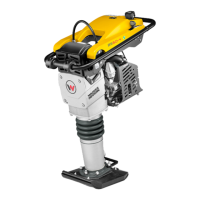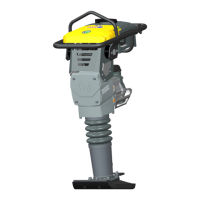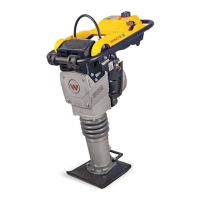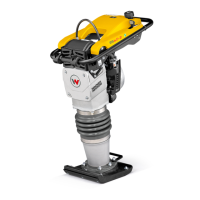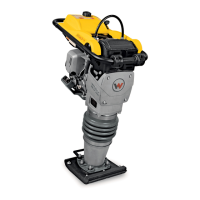Do you have a question about the Wacker Neuson WP 1235A and is the answer not in the manual?
Provides information and procedures for safe operation and maintenance, emphasizing reading and observing safety instructions.
Instructions for keeping the manual with the machine and obtaining replacements if lost.
States that information is based on current production and subject to change without notice.
Details copyright ownership and restrictions on reproduction and distribution.
Explains signal words (DANGER, WARNING, CAUTION, NOTICE, NOTE) and the safety alert symbol for hazard communication.
Defines DANGER as a situation with a high risk of death or serious injury if not avoided.
Defines WARNING as a situation with a risk of death or serious injury if not avoided.
Defines CAUTION as a situation with a risk of minor or moderate injury if not avoided.
Defines NOTICE as a situation that may result in property damage if not avoided.
Indicates additional information crucial for understanding or performing a procedure.
Details requirements for spark arresters on internal combustion engines in certain locations and their qualification.
Emphasizes the necessity of proper training and familiarity for safe machine operation.
Highlights special hazards associated with internal combustion engines during operation and fueling.
Warns that poorly maintained machines are hazardous and emphasizes the need for regular maintenance.
Illustrates the location of various warning and informational labels on the machine.
Describes the meaning and purpose of various international pictorial labels found on the machine.
Provides detailed specifications for the engine, including model, power, spark plug, and oil requirements.
Lists key physical and operational specifications of the machine, including weight, speed, and dimensions.
Details the guaranteed sound power level, sound pressure level, and vibration exposure for the machine.
Illustrates the overall dimensions of the WP 1235A vibroplate with measurements.
Specifies the type of fuel required for the engine: fresh, clean, unleaded gasoline.
Describes the intended uses of the vibroplate, including compacting soils, gravel, and paving stones in confined areas.
Lists essential checks to perform before starting the machine, including fluid levels and component condition.
Provides step-by-step instructions for starting the engine, including fuel valve, switch, throttle, and starter rope operation.
Details the procedure for safely stopping the engine, including throttle, switch, and fuel valve operations.
Offers guidance on running the machine, managing soil conditions, and specific compaction techniques for asphalt and paving stones.
Provides a schedule for routine engine maintenance tasks based on operating hours.
Outlines routine maintenance tasks for the machine, categorized by service intervals.
Covers spark plug inspection, cleaning, replacement, and gap setting for proper engine function.
Explains servicing the dual element air cleaner, including cleaning and replacement procedures and warnings.
Details engine oil draining, refilling, and environmental protection measures during oil changes.
Guides on adjusting the engine's idle speed and warns against exceeding specified operating speeds.
Provides steps for adjusting the carburetor's pilot and throttle stop screws, with notes on limiter caps.
Details the procedure for cleaning the fuel sediment cup, including turning off the fuel valve and using solvent.
Describes the heavy-duty frame design for protection and highlights the central lifting point.
Explains the importance of exciter lubrication, checking oil levels, changing oil, and warnings against overfilling.
Advises on cleaning the plate after use and checking/cleaning engine cooling fins to prevent overheating.
Covers safe manual and mechanical lifting procedures, including cooling, body mechanics, and handling warnings.
Provides essential precautions for transporting the machine, including cooling, securing fuel, and tie-down methods.
Outlines the steps for storing the machine for over 30 days, including cleaning and fluid changes.
Offers solutions for common problems like lack of speed, no vibration, or uneven compaction.
Provides information and procedures for safe operation and maintenance, emphasizing reading and observing safety instructions.
Instructions for keeping the manual with the machine and obtaining replacements if lost.
States that information is based on current production and subject to change without notice.
Details copyright ownership and restrictions on reproduction and distribution.
Explains signal words (DANGER, WARNING, CAUTION, NOTICE, NOTE) and the safety alert symbol for hazard communication.
Defines DANGER as a situation with a high risk of death or serious injury if not avoided.
Defines WARNING as a situation with a risk of death or serious injury if not avoided.
Defines CAUTION as a situation with a risk of minor or moderate injury if not avoided.
Defines NOTICE as a situation that may result in property damage if not avoided.
Indicates additional information crucial for understanding or performing a procedure.
Details requirements for spark arresters on internal combustion engines in certain locations and their qualification.
Emphasizes the necessity of proper training and familiarity for safe machine operation.
Highlights special hazards associated with internal combustion engines during operation and fueling.
Warns that poorly maintained machines are hazardous and emphasizes the need for regular maintenance.
Illustrates the location of various warning and informational labels on the machine.
Describes the meaning and purpose of various international pictorial labels found on the machine.
Provides detailed specifications for the engine, including model, power, spark plug, and oil requirements.
Lists key physical and operational specifications of the machine, including weight, speed, and dimensions.
Details the guaranteed sound power level, sound pressure level, and vibration exposure for the machine.
Illustrates the overall dimensions of the WP 1235A vibroplate with measurements.
Specifies the type of fuel required for the engine: fresh, clean, unleaded gasoline.
Describes the intended uses of the vibroplate, including compacting soils, gravel, and paving stones in confined areas.
Lists essential checks to perform before starting the machine, including fluid levels and component condition.
Provides step-by-step instructions for starting the engine, including fuel valve, switch, throttle, and starter rope operation.
Details the procedure for safely stopping the engine, including throttle, switch, and fuel valve operations.
Offers guidance on running the machine, managing soil conditions, and specific compaction techniques for asphalt and paving stones.
Provides a schedule for routine engine maintenance tasks based on operating hours.
Outlines routine maintenance tasks for the machine, categorized by service intervals.
Covers spark plug inspection, cleaning, replacement, and gap setting for proper engine function.
Explains servicing the dual element air cleaner, including cleaning and replacement procedures and warnings.
Details engine oil draining, refilling, and environmental protection measures during oil changes.
Guides on adjusting the engine's idle speed and warns against exceeding specified operating speeds.
Provides steps for adjusting the carburetor's pilot and throttle stop screws, with notes on limiter caps.
Details the procedure for cleaning the fuel sediment cup, including turning off the fuel valve and using solvent.
Describes the heavy-duty frame design for protection and highlights the central lifting point.
Explains the importance of exciter lubrication, checking oil levels, changing oil, and warnings against overfilling.
Advises on cleaning the plate after use and checking/cleaning engine cooling fins to prevent overheating.
Covers safe manual and mechanical lifting procedures, including cooling, body mechanics, and handling warnings.
Provides essential precautions for transporting the machine, including cooling, securing fuel, and tie-down methods.
Outlines the steps for storing the machine for over 30 days, including cleaning and fluid changes.
Offers solutions for common problems like lack of speed, no vibration, or uneven compaction.
| Engine type | WM 80 |
|---|---|
| Operating weight | 64 kg |
| Impact force | 12 kN |
| Engine power | 1.8 kW |
| Percussion force | 12 kN |
| Fuel type | Gasoline |
| Fuel tank capacity | 3 l |
| Centrifugal force | 12 kN |
| Tamping foot width | 280 mm |
